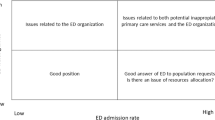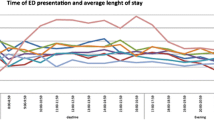Abstract
Background
Overcrowding is one of the most harmful problems for Emergency Department (ED) management and the correct estimation of time resource absorption by each type of patient plays a strategic role in dealing with overcrowding and correctly programming ED activity.
Objective
We aimed to investigate how overcrowding may affect urgent patients’ waiting times (i.e., the robustness of the triage patient priority system) and to evaluate the extra costs due to inappropriate use of EDs.
Methods
Data referring to 54,254 patients who accessed the ED of a major Italian hospital in 2011 were analyzed to study patient flows and overcrowding. To define an average per-patient cost, according to the severity of his or her health condition, the 2010 profit and loss account of the aforementioned hospital was studied and the time devoted by physicians to each type of patient was estimated by means of a self-reported survey.
Results
Empirical findings confirm a positive correlation between overcrowding and the time a patient has to wait before receiving treatment. This effect is relevant only for non-urgent patients who are responsible for the overcrowding itself. However, urgent patients’ waiting times do not increase in the presence of overcrowding, confirming that the triage priority system is robust against the overcrowding situation. The analysis estimates, using 2010 data, that the actual per patient cost incurred by the hospital when treating white-coded patients is, on average, 36.54 euros; a green code costs 93.17, yellow 170.62, and red 227.62. It emerges that 4 % of all the personnel costs are attributable to white color-code assistance, 67 % to green codes, 23 % to yellow codes, and the remaining 6 % to red codes.
Conclusion
The implementation of effective policies intended to improve both efficiency and quality in providing emergency health services has to deal with the systemic problem of inappropriate use of EDs. Policy-makers should be aware of the fact that there is a considerable portion of ED demand for assistance that is inappropriate and that oversizing EDs with respect to the true, appropriate, urgent patients’ demands, could bring about a further and undesirable rise in inappropriate assistance demands and, therefore, an increase in ED costs that are not consistent with their objectives.


Similar content being viewed by others
Notes
Although a precise definition for overcrowding does not exist [2, 3], in general terms it is possible to state that it occurs when the number of people requiring services exceeds the capacity of the structure providing those services [4]. The literature is concordant in ascribing this lack of capacity to several causes such as the increase in patient acuity, complexity, and volume [2], as well as bed and staff shortages [2, 5]. However, the most important cause is, at least with reference to the Italian health system, the inappropriate use of EDs by patients who ask for non-urgent medical assistance [1, 6–9].
See also [12].
The cost estimates were conducted using data from the E. O. Ospedali Galliera 2010 balance sheet.
It is possible that an ED signals to the “emergency operations center” that it is crowded and asks them to divert patients to other hospitals. However, the afore-mentioned situation is an exceptional one that occurs on very few days a year. Furthermore, it has to be noted that only those patients who pass through the “emergency operations center” can be diverted to other “non-crowded” EDs, while patients using their own vehicles are not.
All the statistical analyses presented in this work have been run using R (Development Core Team, 2012). R: a language and environment for statistical computing. R Foundation for Statistical Computing, Vienna, Austria. ISBN 3-900051-07-0, URL: http://www.R-project.org/.
References
Grumbach K, Keane D, Bindman A. Primary care and public emergency department overcrowding. Am J Public Health. 1993;83(3):372–8.
Derlet RW, Richards JR, Kravitz RL. Frequent overcrowding in US emergency departments. Acad Emerg Med. 2001;8(2):151–5.
Cowan RM, Trzeciak S. Clinical review: Emergency department overcrowding and the potential impact on the critically ill. Crit Care. 2005;9(3):291–5.
Gordon JA, Billings J, Asplin BR, Rhodes KV. Safety net research in emergency medicine: proceedings of the Academic Emergency Medicine Consensus Conference on ‘The Unraveling Safety Net’. Acad Emerg Med. 2001;8:1024–1029.
de Araujo P, Khraiche M, Tukan A. Does overcrowding and health insurance type impact patient outcomes in emergency departments? Health Econ Rev. 2013;3:25.
Bianco A, Pileggi C, Angelillo IF. Non-urgent visits to a hospital emergency department in Italy. Public Health. 2003;117:250–5.
Trzeciak S, Rivers EP. Emergency department overcrowding in the United States: an emerging threat to patient safety and public health. Emerg Med J. 2003;20:402–5.
Cremonesi P, di Bella E, Montefiori M. Cost analysis of emergency department. J Prev Med Hygiene. 2010;51(4):157–63.
Ameri A, Cremonesi P, Montefiori M. The effects of inappropriate emergency department use. Studi Economici. 2011;105(3):123–36.
McCarthy ML, Aronsky D, Jones ID, et al. The Emergency Department occupancy rate: a simple measure of emergency department crowding. Ann Emerg Med. 2008;51(1):15–24.
McCarthy ML, Zeger SL, Ding R, et al. Crowding delays treatment and lengthens emergency. Ann Emerg Med. 2009;54(4):492–503.
Cremonesi P, Montefiori M, Resta M. Hospital emergency department: an insight by means of quantitative methods. Open Pharmacoeconom Health Econom J. 2012;4:26–35.
Pines JM, Hilton JA, Weber EJ, Alkemade AJ, Al Shabanah H, Anderson PD, Bernhard M, Bertini A, Gries A, Ferrandiz S, Kumar VA, Harjola VP, Hogan B, Madsen B, Mason S, Ohlén G, Rainer T, Rathlev N, Revue E, Richardson D, Sattarian M, Schull MJ. International perspectives on emergency department crowding. Acad Emerg Med. 2011;18:1358–70.
Lippi Bruni M, Mammi I, Ugolini C (2014). Does the extension of primary care practice opening hours reduce the use of emergency services? Working Paper DSE N° 978. Available at SSRN: http://ssrn.com/abstract=2524268 or http://dx.doi.org/10.2139/ssrn.2524268.
Farrohknia N, Castrén M, Ehrenberg A, Lind L, Oredsson S, Jonsson H, Asplund K, Göransson KE. Emergency department triage scales and their components: a systematic review of the scientific evidence. Scand J Trauma Resusc Emerg Med. 2011;19:42.
Levaggi R, Montefiori M. Definition of a prospective payment system to reimburse the emergency department. BMC Health Serv Res. 2013;13:409.
di Bella E, Montefiori M. Modelling activity and costs of health emergency department. In: Testi A, Tanfani E, Ivaldi E, Carello G, Aringhieri R, Fragnelli V, editors. Operations Research for Patient. Centered Health Care Delivery. Milano: Franco Angeli; 2010. pp. 176–188.
Lee A, Lau FL, Hazlett CB, Kam CW, Wong P, Wong TW, Chow S. Measuring the inappropriate utilization of accident and emergency services. Int J Health Care Qual Assur. 1999;12(7):287–92.
Conflict of interest
The authors have no conflicts of interest to declare.
Authors’ contributions
Although all authors contributed to the conception of the study, the design of the study, and writing of the manuscript, M. Montefiori can be identified as the guarantor for the overall content, economic analysis, and interpretation of the results. E. di Bella and L. Persico are equally responsible for the design of the survey and the subsequent data analysis. P. Cremonesi is the provider of the data used for the analysis.
Acknowledgments
The authors would like to thank E. O. Ospedali Galliera for their special cooperation in providing the data.
Author information
Authors and Affiliations
Corresponding author
Appendices
Appendix 1: Statistical procedure implemented to recover 282 missing values and to evaluate the time devoted to each patient by each physician
First step: the visiting time distributions of the 18 physicians that attended more than ten patients are standardized, with respect to mean and variance, in order to have distributions with a zero mean and unitary variance and, de facto, neutralizing the difference in mean and dispersion among the different physicians.
Second step: these standardized values are used to estimate the following model:
where V T is the standardized visiting time, \( D_{\text{g}} ,\;D_{\text{y}} ,\;D_{\text{r}} \) are the triage colour dummies referring to three (g: green, y: yellow and r: red) of the four tags. The white code (w) dummy is not required in the regression as it is confounded with the intercept, G is the gender dummy (male = 1; female = 0), A is the patient’s age, P nl is the number of non-laboratory patient prescriptions, P l is the number of laboratory patient prescriptions, EDC is the emergency department crowding measured as the number of triaged patients who are simultaneously waiting for their first examination, H is the hospitalization dummy (hospitalized = 1; not hospitalized = 0), FT is the fast track dummy (fast-tracked patient = 1; non-fast-tracked patient = 0)
The estimates of the parameters of model (3) and their observed significance levels (p values) are provided in Table 3.Footnote 5
Third step: the 282 missing values are estimated using the predicted values according to model (3)
Fourth step: all the standardized values (444 real and 282 predicted) are de-standardized using a 5 % trimmed mean and 5 % trimmed variance (calculated on the 444 real values), in order to cut 10 % of the extreme values (highest and lowest).
Multicollinearity and endogenity validation: The absence of multicollinearity has been checked using the Variance Inflation Criterion (VIF) and all the variables were found to have a generalized VIF value that is below 1.5, providing evidence of the absence of multicollinearity. In addition to this, the possibility that the EDC variable, although almost not significant, could be endogenous, was checked. As credible instrumental variables to run a Durbin–W–Hausman test are not available, the correlation between the residuals of the linear model (3) excluding EDC and the EDC variable was checked and we found that this correlation is not significantly different from zero (−0.0103; p value = 0.7821). Therefore, we exclude the possibility of endogenity in the model due to a variable that is, moreover, almost not significant (p value = 0.092).
Appendix 2: Queue and waiting time
Figure 2 represents the average waiting time for urgent and non-urgent patients split into day and night shifts. This is tantamount to judging overcrowding based on 12-h time slots (i.e., the duration of both the day and the night shift). Within 12-h periods there can be overcrowding for some periods of time, even on days when the total number of patients is not particularly high. For this reason a different approach to computing the number of patients waiting for examination at the ED at each particular time was implemented. The single per-patient records in the database were used to derive the real-time flow of patients, i.e., the number of patients waiting for medical assistance for any triage color at any time in 2011.
The queue faced by each patient accessing an ED at each particular time was estimated in other terms. Henceforth patients were grouped according to their waiting queue, the latter expressed as the number of patients already waiting at the ED for their first examination, at the time the accessing patient is triaged.
Six different classes were considered: 0–5; 6–10; 11–15; 16–20; 21–25; >25
To give an example, class 6–10 includes all the patients who, in 2011, arrived at the Galliera Hospital ED facing a queue of a minimum of six to a maximum of ten patients. The last class is comprised of all the patients who faced a queue of greater than 25 patients. For example, if 30 patients are waiting at the ED for their first examination at the time when a new patient arrives, then he would be included in this class (>25). We have grouped patients according to their priority tag, i.e., non-urgent (white and green tag) and urgent (yellow and red). Table 4 below presents the results obtained, which confirm those presented in Fig. 2 where 12-h slots, night/day shifts, and patient flow class were considered.
Rights and permissions
About this article
Cite this article
Cremonesi, P., di Bella, E., Montefiori, M. et al. The Robustness and Effectiveness of the Triage System at Times of Overcrowding and the Extra Costs due to Inappropriate Use of Emergency Departments. Appl Health Econ Health Policy 13, 507–514 (2015). https://doi.org/10.1007/s40258-015-0166-5
Published:
Issue Date:
DOI: https://doi.org/10.1007/s40258-015-0166-5




